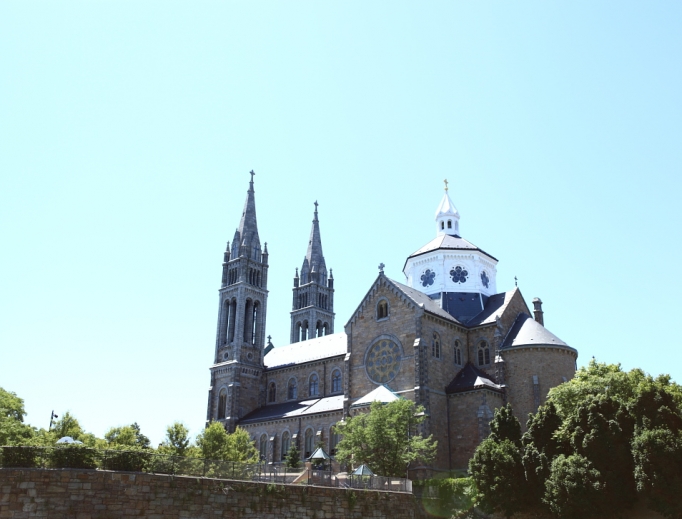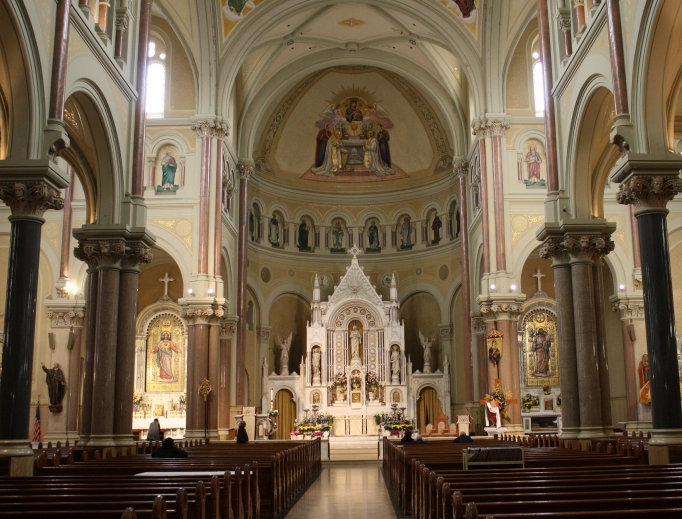A Marian Pilgrimage to Boston’s Spiritual Beacon
Basilica of Our Lady of Perpetual Help Is a Tribute to Mary in Marble and Stone

The Basilica of Our Lady of Perpetual Help, Mission Church and “Lourdes in the Land of the Pilgrims” are three titles that grace a beautiful church two miles from historic downtown Boston, not far from the home of famed patriot Paul Revere.
This edifice is a study in sacred art, marble and stone, all created in thanksgiving to Our Lady of Perpetual Help, whose memorial is celebrated June 27.
Our Lady of Perpetual Help was named the first basilica in New England Dec. 8, 1954, the last day of a Marian year and the 100th anniversary of the proclamation of the dogma of the Immaculate Conception. Before then, it was already renowned because of seemingly miraculous healings connected with it.
These healings began before this 215-feet-long Romanesque church was built from a local quarry’s puddingstone and dedicated April 7, 1878. It replaced the original wooden church that the Redemptorists — the Congregation of the Most Holy Redeemer founded by St. Alphonsus Liguori — had established as a mission to scores of German immigrants living and working in this section of town called Roxbury.

That’s how the “Mission Church” name originated. Shortly after the mission was founded, on Pentecost Sunday 1871, the mystical icon of Our Lady of Perpetual Help was solemnly enthroned above the old church’s altar.
That spawned scores of miraculous cures that have allegedly occurred for 140 years. By the turn of the 20th century, healings of illnesses that specialists branded incurable were so widespread that newspapers around the nation were recounting miracle after miracle and calling the church “Lourdes in the Land of the Pilgrims.”
By then, readers had learned the story of Grace Hanley, a young girl who was injured in an accident after the Civil War. After she and her family made several novenas at the church’s shrine, she was reportedly healed. Her cure received wide attention because her father was a well-known Civil War officer who for years had taken her to many doctors, none of whom could help. Grace went on to enter religious life, joining the Sisters of Jesus and Mary.
To this day, people offer tributes of unending thanks.
Flanking the magnificent shrine chapel of Our Lady of Perpetual Help, two huge “vases” hold neatly arranged crutches and canes left by those cured. On one of the repositories, the Hanley family donated a plaque that reads, “Miss Grace Hanley cured Aug. 18, 1883.” An old book written by the church, containing descriptions of the church’s stained-glass windows and their donors, notes that the Hanley family window depicts Jesus’ agony in the garden.
Almost from the beginning, the shrine and icon of Our Lady of Perpetual Help made Mission Church a spiritual beacon.
By 1910, the church’s 215-foot-tall twin steeples could be seen from across the city. They were prominent landmarks for the thousands of pilgrims who literally overflowed the eight Wednesday novena services to Our Lady.
Redemptorist Father Joseph Manton, who lived in the rectory for 56 years until he died in 1998, directed these novenas.
Restored Beauty
A year’s major renovation shortly after the beginning of the new millennium restored the basilica’s rare beauty. The massive 1897 Hutchings pipe organ, built in Boston, was also restored.
Highly detailed and brilliantly colorful scenes from the Gospel, the Holy Family and religious events like Lourdes from the world-renowned Munich studios in the 1890s line the nave.
Every intricately carved detail graces the towering white Carrara marble main altar, which is the focal point of the church’s seven altars. The Redemptorists enshrined a large statue of Our Lady of Sorrows, sculpted from a single piece of Carrara, over the main tabernacle, because Our Lady of Perpetual Help is only represented as a painting, never in statue form, and Our Lady of Sorrows is thought to have the closest resemblance to the “Perpetual Help” title.
To the side of the statue stand marble statues of Sts. Michael and Gabriel, along with seven cherubs and two angels with wings outspread on the reredos sounding their trumpets.
Around the apse at triforium height, Old Testament figures, along with saints who founded religious orders, like Dominic, Benedict and Francis, are positioned around the altar. Still higher in the apse, a mural of Our Lady of Perpetual Help is encircled by radiant gold, flanked by angels in homage and enshrined above an altar with a monstrance, includes images of the primary Redemptorist saints — Alphonsus Ligouri, John Neumann, Clement Hofbauer and Gerard Majella — adoring the Blessed Sacrament. (The Redemptorists have a distinctive connection to this title of Our Lady since 1866, when Blessed Pius IX entrusted the original icon of Our Lady of Perpetual Help to the order, which is now enshrined in the Church of St. Alphonsus in Rome.)

The nearest side altars honor the Sacred Heart, St. Joseph, the Holy Family and St. Patrick — all in large mosaics of German designs realized in fire-treated glass.
The St. Joseph altar depicts the patron of the universal Church and his foster son. The right transept’s monumental Purgatorian altar pictures angels hovering near Jesus Crucified, escorting souls to heaven and guarding the tabernacle. Angels appear everywhere, even carved into the Corinthian capitals of marble columns. A huge angel shimmering in blue mosaic and another in pink hold a banner announcing, “Ave Maria” above the majestic Shrine Chapel of Our Lady of Perpetual Help that fills the left transept. In the miraculous icon of Our Lady of Perpetual Help, the images of Mary and the Child Jesus are enthroned above the tabernacle within a dazzling golden frame bursting with sunrays and cherub faces. Around Our Lady, the shining gold mosaic wall and dome radiate splendor and warmth.
The reminder of Mary’s intercession for restoration to health and redemption continues in a mural that fills the enormous dome. Victorious Christ the Redeemer (the symbol of the Redemptorists) is shown at the center, along with a depiction of Mary as Queen of Heaven. The Marian image is surrounded by portrayals of petitioning crowds — the sick, infirm and those healed, including an image of a woman holding her child toward Mary, a bride and groom, and Redemptorist saints.
One depicted group of three priests and a nun shows Father Manton and another Redemptorist, the late Father Edward McDonough, who conducted regular healing services in the church for more than two decades. Currently, Redemptorist Father Robert Lennon conducts the healing services every last Sunday of the month.
Throughout this sacred space, the basilica’s composition of statues, paintings, mosaics and marbles indeed comes together in beautiful harmony.
Joseph Pronechen is a
Register staff writer.
Online: BostonsBasilica.com

















